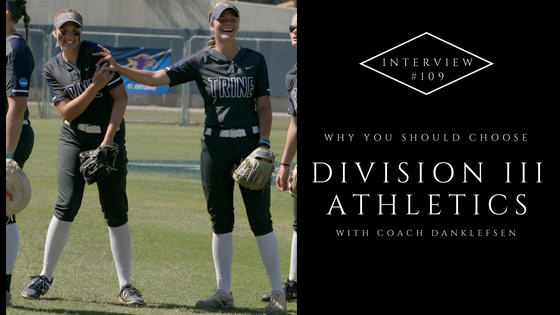I am pleased to share with you the wisdom of NCAA Division III Softball Coach of Trine University Donnie Danklefsen.
Coach Donnie Danklefsen has been at the helm of Trine Softball since 2004. He has created a conference powerhouse and ranks as one of the nation’s elite Division III athletic teams. The Thunder softball team has been to the NCAA Regionals 11 consecutive times. In 2014 and 2017 they reached the NCAA Division III Championship. Under Coach Danklefsen, Trine are an amazing 438-158.
Coach Danklefsen knows a thing or two about how to recruit the right players to his program.
Welcome to Interview #109
What can or should high school athletes do from their end to get on your radar screen? What are the important steps for an athlete to get noticed by you?
The best way a Prospective Student Athlete (PSA) can get noticed is to email, call, text and get to that university’s camp or clinic. Ask how many kids will be at the camp/ clinic. The PSA needs to recruit that university and program. I get so many generic emails, so if they don’t spell my name right, say something about our university, select a major that we have they get removed. The best way is to text or even better call, then get on campus.
Many parents won’t consider Division III athletics because Division III does not offer athletic scholarships and they are convinced they can’t afford it. What would you say to those parents?
I would tell those parents that Division III is not a great fit for every kid. A great student that wants academics to be the first priority can be a great fit. I would ask them how much are they spending on travel ball, has there kid 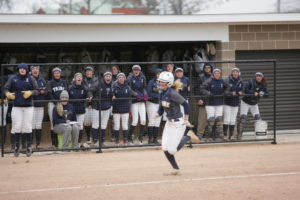 taken the SAT/ACT more than once? I would also tell them that most Division III packages are not much higher than a kid on a NAIA or Division I partial scholarship. I have had several Division I transfers and they paid almost the same thing. They were not full ride Division I kids and great student athletes.
taken the SAT/ACT more than once? I would also tell them that most Division III packages are not much higher than a kid on a NAIA or Division I partial scholarship. I have had several Division I transfers and they paid almost the same thing. They were not full ride Division I kids and great student athletes.
The other concern I heard was that because there are no athletic scholarships at Division 3, the level of play will be too low for their child. Is the level of play low?
Division III athletics has the widest spectrum of talent of any division. I would tell them do not judge a book by its cover. Yes, there are some very poor Division III teams that would lose to high school teams. There are also Division III teams that compete with Mid Major Division I teams. We had a pitcher throwing 67 and several kids that have turned down Division I/Division II/NAIA offers. We have beaten the number 2 ranked team in Division II before and beaten Division I teams.
They must do their homework and look at each program just like all the other levels out there. The best teams are very good and the level of play is not poor at all. I had a 4 time All-American that was a two sport athlete. She made the NPF Tryout over Arizona and Wisconsin starting CF’s. This athlete could not of played two sports at Division I level.
Why do you think athletes should consider Division III athletics? What are the benefits of Division III specifically?
Why Division III? Academic first, small classes, life outside of softball, less travel, not a business. Our kids can have two majors, jobs, be involved in much more academic and athletic activities. For us engineering is our top draw; we are nationally recognized for engineering. Our kids will never have to pick engineering or softball. They know softball will work around the vigorous engineering schedule.
Similar question, why should student-athletes consider Division III athletics? How does the Division III experience differ from the Division I and II experience?
A lot of kids are misled by travel coaches and go to a Division I or Division II level when they have only 1 or 2 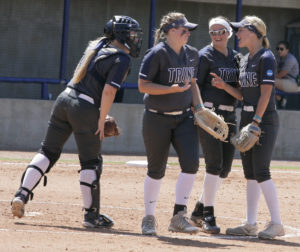 Division I skill sets. These kids get partial scholarships and very little playing time. If they where at the Division III LEVEL they could possibly be 4 year starters and the face of a program.
Division I skill sets. These kids get partial scholarships and very little playing time. If they where at the Division III LEVEL they could possibly be 4 year starters and the face of a program.
At the Division III level these kids are treated much different. They are not a $ amount and are playing for the love of the game. Division I is for the select few, but the Division III experience can be just as gratifying.
We just graduated a 2 time All American who would of sat for 2 years, and then been a dh. She is a 4 year starter, all-time leader for our conference and our university in homeruns and rbi’s. She played in a world series, 2 super regionals, 4 regionals. She was one of the best hitters in Division III. She loved her experience.
How important are 3rd party recruiting companies such as NCSA and NSR for you in finding athletes? Are they a benefit to the high school athletes?
We have had some luck with NCSA and NSR. When used in the right context they can benefit the high school athlete.
What should recruits and their parents keep their eyes open for when they are on a campus visit?
Are they allowed to spend time with players when the coaching staff not present? How many players are on a roster? Is this a mass recruiting school? Are they an admissions number or an important piece of the softball program? Is the campus safe? Is the size the right fit for them not mom, dad, or their travel coach. This is their time to be selfish.
What does the offseason, spring season and summer look like for a Division 3 softball player? Talk about any NCAA restrictions as they apply. Talk about time commitments.
The offseason at Division III is much different than the Division I or Division II level. Known as the dead period we cannot conduct any team or individual workouts. Our kids are in the gym, weight room and cages all the time but there is no instruction allowed. They understand this is the time to take the instruction from the fall and get better. We hold hitting and pitching clinics during this time as well.
During the spring season, unlike Division I and Division II, we don’t have time restrictions or track hours. We can practice 7 straight days before a mandatory off day. Spring season starts typically the 3rd week of January and we hope it runs until Memorial Day weekend. We typically practice 6 days a week until our spring trip that falls early March. During the fall (nontraditional season) and spring (traditional season) our hitters, pitchers and catchers will come in 2x a week for individual training. Our hitters average 10-12 hours a week on improving the swing.
We train as much as Division I or Division II athletes but have less travel and much more flexibility with academics.
Our fall ball season is 4 weeks with 4 days per week allowed and 1 day of competition with a total of 3 games max. This runs during the month of September.
Can you give us examples of how meeting the demands of collegiate athletics has prepared your former players in their lives after college?
I had a former player call me recently just to say thank you so much. She had graduated a few years back and went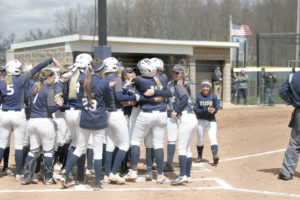 to get her masters and was completing a very rigorous, highly competitive medical school to become a doctor. A very low percentage of candidates complete the program. They were told they were not going to be able to have a part time job and get through this program. She not only had 1, job but worked 2 part time jobs and finished the program with honors.
to get her masters and was completing a very rigorous, highly competitive medical school to become a doctor. A very low percentage of candidates complete the program. They were told they were not going to be able to have a part time job and get through this program. She not only had 1, job but worked 2 part time jobs and finished the program with honors.
The doctor who runs the whole program pulled her aside and said you must have been an athlete in undergrad. He said, you thrive under pressure and strive in the competition of this program. You can tell you love to compete and have learned how to be on the big stage. She responded with yes, I was a pitcher on one of the best Division III teams in the country.
She told me she didn’t always understand why I held her and the team to such high standards. She didn’t understand all of the things I made them do when she played, but now understands where I was coming from. All of the time management and pressure of being a college athlete/ pitcher prepared her to get through the medical program. Others quit and couldn’t handle the pressure, but she was used to it. It reminded her of making the run to the NCAA Division III World Series.
What is the nature of your relationships with your current players?
Trine Softball is a family. Our kids come in the office and talk for hours. They just like to hang out.
How does the relationship change over their lives as they move onto careers and families of their own?
Most players stay in touch. I always have a ton weddings each summer. They bring their kids back and they play with my son. They are always writing letters and coming back to speak with the current team. You might not see them for years but it’s like they never left when they come back.
Bonus Question: Is there anything important that you would like to share directly with high school athletes or softball players in particular as they navigate the recruiting process?
Don’t go where a travel coach tells you is the best fit. You go to the university that will best prepare you to be 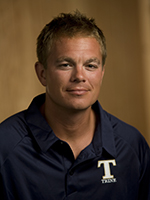 successful in life. If you didn’t play softball there, would you still be happy there?
successful in life. If you didn’t play softball there, would you still be happy there?
Profile:
To see Coach Donnie Danklefsen’s full bio, click here.
Next, check out: Great Athletes Avoid Division 3 Schools. True or False?
LIKE WHAT YOU READ?
Please take a moment to share this on social media to benefit other prospective college athletes, by clicking on the “sharing is caring” buttons below.
Thanks,
Bryan
P.S. Come join our Facebook group, The Recruiting Code. This is the place to be for parents and coaches to talk about college recruiting. Come learn from each other, share stories and get information that will help your child become a college athlete.


